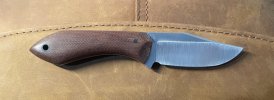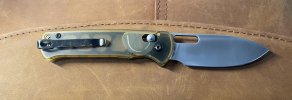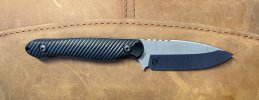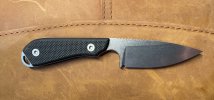-
The BladeForums.com 2024 Traditional Knife is available! Price is $250 ea (shipped within CONUS).
Order here: https://www.bladeforums.com/help/2024-traditional/
You are using an out of date browser. It may not display this or other websites correctly.
You should upgrade or use an alternative browser.
You should upgrade or use an alternative browser.
Would people be interested in seeing PMI results on knife steel?
- Thread starter Maxaem
- Start date
- Joined
- Jun 29, 1999
- Messages
- 9,995
I only buy knives from reputable outfits, so I'm OK without atomic analysis.
argyle1812
Gold Member
- Joined
- Mar 6, 2016
- Messages
- 1,811
I would love to see some examples tested
- Joined
- Jul 11, 2024
- Messages
- 40
I've had a lot going on, sorry I haven't posted for a while.
First off, unless I take the materials in for destructive testing at our ISO certified facility, the results should be taken with a grain of salt as has been said by other users. Everything here is information only. I'm doing this for fun. I find it interesting how different alloying elements affect qualities of steel and I have access to equipment most folks don't. I have to identify materials being used in various applications. Sometimes it's verification that the material is the material claimed by the seller, sometimes it is an unknown material for a component that needs to be replaced. This testing is very important in real world applications. Using incorrect materials for an application can lead to minor or catastrophic failures. I am certified to use the equipment that I use. I will probably shy away from OES unless I can remove handle scales and test somewhere inconspicuous, or I'm trying to differentiate between carbon steels or other steels that are very similar outside of their carbon content. A lot of these alloys have distinct enough composition with other elements that it isn't a big deal for differentiating them without using OES.
As another user mentioned, these results will really only apply to the sample I have. Manufacturers strive for homogeneity in their products, but there are variances and that is normal. Like I said previously, there are typically ranges associated with each alloying element, and these ranges can be percentage points. Unless something is just plain wrong, there is no need to raise any pitchforks. If something is pretty close, it's likely the right material, these test methods aren't perfect and I'm not going to destroy a good knife so that I can be certain the thing I liked was a prime specimen of a given alloy.
Anyway, this morning I did a few tests using XRF. Calibration with these units is really more of a verification that a unit is operating as intended rather than calibration that might be done with other equipment. They are pretty reliable, close enough in most situations, albeit imperfect. I'm using an Olympus Vanta, performing multiple tests, and testing known reference standards. Admittedly, I don't have any known standards on hand at the moment with Vanadium concentrations as high as in most of the alloys tested. My suspicion is that this unit is currently reading Vanadium a little bit on the low side, but I will have to do some further investigation there.
Today I tested a S90V Hectare from CJRB, a D2 Scuttler from Kizer, and a Magnacut Esker M from Boatright Bladeworks. They're just what I had on me. Limited elements listed, I'll spruce up the format and try to get some established ranges next time. For now, you'll have to refer to u/Larrin Knife Steels Rated by a Metallurgist article.
Nothing from the results really stands out to me other than the Vanadium readings being slightly low, possibly due to equipment. That discrepancy is most evident in the Scuttler, but again nothing flag raising. Everything else seems to be in line with the compositions posted in the linked article.
First off, unless I take the materials in for destructive testing at our ISO certified facility, the results should be taken with a grain of salt as has been said by other users. Everything here is information only. I'm doing this for fun. I find it interesting how different alloying elements affect qualities of steel and I have access to equipment most folks don't. I have to identify materials being used in various applications. Sometimes it's verification that the material is the material claimed by the seller, sometimes it is an unknown material for a component that needs to be replaced. This testing is very important in real world applications. Using incorrect materials for an application can lead to minor or catastrophic failures. I am certified to use the equipment that I use. I will probably shy away from OES unless I can remove handle scales and test somewhere inconspicuous, or I'm trying to differentiate between carbon steels or other steels that are very similar outside of their carbon content. A lot of these alloys have distinct enough composition with other elements that it isn't a big deal for differentiating them without using OES.
As another user mentioned, these results will really only apply to the sample I have. Manufacturers strive for homogeneity in their products, but there are variances and that is normal. Like I said previously, there are typically ranges associated with each alloying element, and these ranges can be percentage points. Unless something is just plain wrong, there is no need to raise any pitchforks. If something is pretty close, it's likely the right material, these test methods aren't perfect and I'm not going to destroy a good knife so that I can be certain the thing I liked was a prime specimen of a given alloy.
Anyway, this morning I did a few tests using XRF. Calibration with these units is really more of a verification that a unit is operating as intended rather than calibration that might be done with other equipment. They are pretty reliable, close enough in most situations, albeit imperfect. I'm using an Olympus Vanta, performing multiple tests, and testing known reference standards. Admittedly, I don't have any known standards on hand at the moment with Vanadium concentrations as high as in most of the alloys tested. My suspicion is that this unit is currently reading Vanadium a little bit on the low side, but I will have to do some further investigation there.
Today I tested a S90V Hectare from CJRB, a D2 Scuttler from Kizer, and a Magnacut Esker M from Boatright Bladeworks. They're just what I had on me. Limited elements listed, I'll spruce up the format and try to get some established ranges next time. For now, you'll have to refer to u/Larrin Knife Steels Rated by a Metallurgist article.
| Steel-Knife | C (%) | Cr (%) | +/- | Mo (%) | +/- | V (%) | +/- | W (%) | +/- | Co (%) | +/- | Nb (%) | +/- | Ni (%) | +/- | Other | |
| S90V - CJRB Hectare | NA | NA | 14.62 | .28 | 1.031 | .026 | 8.30 | .33 | .193 | .055 | NA | NA | .037 | .005 | .243 | .068 | |
| D2 - Scuttler Kizer | NA | NA | 11.91 | .15 | .89 | .015 | .523 | .060 | .025 | .022 | NA | NA | .167 | .006 | .247 | .051 | |
| Magnacut - Esker M Boatright Bladeworks | NA | NA | 10.72 | .23 | 2.080 | .037 | 3.79 | .22 | .099 | .046 | NA | NA | 2.42 | .037 | .202 | .065 |
Nothing from the results really stands out to me other than the Vanadium readings being slightly low, possibly due to equipment. That discrepancy is most evident in the Scuttler, but again nothing flag raising. Everything else seems to be in line with the compositions posted in the linked article.
Chronovore
Gold Member
- Joined
- Aug 29, 2019
- Messages
- 11,981
I've had a lot going on, sorry I haven't posted for a while.
First off, unless I take the materials in for destructive testing at our ISO certified facility, the results should be taken with a grain of salt as has been said by other users. Everything here is information only. I'm doing this for fun. I find it interesting how different alloying elements affect qualities of steel and I have access to equipment most folks don't. I have to identify materials being used in various applications. Sometimes it's verification that the material is the material claimed by the seller, sometimes it is an unknown material for a component that needs to be replaced. This testing is very important in real world applications. Using incorrect materials for an application can lead to minor or catastrophic failures. I am certified to use the equipment that I use. I will probably shy away from OES unless I can remove handle scales and test somewhere inconspicuous, or I'm trying to differentiate between carbon steels or other steels that are very similar outside of their carbon content. A lot of these alloys have distinct enough composition with other elements that it isn't a big deal for differentiating them without using OES.
As another user mentioned, these results will really only apply to the sample I have. Manufacturers strive for homogeneity in their products, but there are variances and that is normal. Like I said previously, there are typically ranges associated with each alloying element, and these ranges can be percentage points. Unless something is just plain wrong, there is no need to raise any pitchforks. If something is pretty close, it's likely the right material, these test methods aren't perfect and I'm not going to destroy a good knife so that I can be certain the thing I liked was a prime specimen of a given alloy.
Anyway, this morning I did a few tests using XRF. Calibration with these units is really more of a verification that a unit is operating as intended rather than calibration that might be done with other equipment. They are pretty reliable, close enough in most situations, albeit imperfect. I'm using an Olympus Vanta, performing multiple tests, and testing known reference standards. Admittedly, I don't have any known standards on hand at the moment with Vanadium concentrations as high as in most of the alloys tested. My suspicion is that this unit is currently reading Vanadium a little bit on the low side, but I will have to do some further investigation there.
Today I tested a S90V Hectare from CJRB, a D2 Scuttler from Kizer, and a Magnacut Esker M from Boatright Bladeworks. They're just what I had on me. Limited elements listed, I'll spruce up the format and try to get some established ranges next time. For now, you'll have to refer to u/Larrin Knife Steels Rated by a Metallurgist article.
Steel-Knife C (%) Cr (%) +/- Mo (%) +/- V (%) +/- W (%) +/- Co (%) +/- Nb (%) +/- Ni (%) +/- Other S90V - CJRB Hectare NA NA 14.62 .28 1.031 .026 8.30 .33 .193 .055 NA NA .037 .005 .243 .068 D2 - Scuttler Kizer NA NA 11.91 .15 .89 .015 .523 .060 .025 .022 NA NA .167 .006 .247 .051 Magnacut - Esker M Boatright Bladeworks NA NA 10.72 .23 2.080 .037 3.79 .22 .099 .046 NA NA 2.42 .037 .202 .065
Nothing from the results really stands out to me other than the Vanadium readings being slightly low, possibly due to equipment. That discrepancy is most evident in the Scuttler, but again nothing flag raising. Everything else seems to be in line with the compositions posted in the linked article.
There was some controversy over Chinese D2 a few years back. It wasn't that unscrupulous companies were stamping "D2" on everything from 8Cr13Mov to 3Cr13, although that remains a problem with fly-by-night brands and rebranding distributors like Eafengrow. It's that the D2 knives coming out of China didn't always match the edge performance of those American or other knives that built the reputation for "D2". Some of that undoubtedly came down to heat treatment, both between brands and within samples from the same brands. Some companies were running D2 softer than they should (and that continues with a variety of steels in production knives generally). The variance within brands may have suggested issues in attaining even heat treatments in large batches. Another culprit may have been variance within the material itself.
The vanadium values in some of the previously tested Chinese D2 varied more than they should and tended to run on the lower side of the expected range. This might explain some of the variance in the end products. At least partially in response to this, some of the manufacturers specializing in Chinese D2 started importing Bohler K110. Aside from the marketing boost or charging a small premium for the upgrade, Bohler K110 is an analog of D2. Since those companies were already set up to use D2, a cleaner or more consistent starting material might actually be a good thing.
- Joined
- Jun 10, 2024
- Messages
- 1,073
I would love an as close to black and white truth answer as to what Case's CS blades are. They used to be stamped CV and supposedly due to material availability issues they switched and stared marking everything as CS. Then I saw it's all 1095, someone else said it's only 1095 if it's stamped 1095 and the rest is 1084, and I've also read they use whatever they can get so you never know thus marking it CS isn't a lie. Which as I'm typing this I'm realizing you would need a selection of different CS marked blades to see if any of them are different.
I should add that yes I've read https://caseknives.com/blogs/news/the-case-edge-past-present-future and unless it all boils down to they have a rainbow spectrum of acceptable HRC received back from heat treatment then I don't know what else would still cause the questioning.
I should add that yes I've read https://caseknives.com/blogs/news/the-case-edge-past-present-future and unless it all boils down to they have a rainbow spectrum of acceptable HRC received back from heat treatment then I don't know what else would still cause the questioning.
Last edited:
- Joined
- Jul 11, 2024
- Messages
- 40
Round 2, same deal, running a couple tests for fun. I'll still get to putting something more formal together or reach out to the other person mentioned doing similar things.
I pulled out a different analyzer to see if there was a noticeable difference in the Vanadium concentration, but the only knife from yesterday I had was the D2 Scuttler (it lives in a little pouch I move from bag to bag). Results were very similar. I believe 1.10% is a maximum on the Vanadium and I'm not sure that a minimum is defined, though it might be in some code applications. Separate note, I want to ask some metallurgists about performance variations in a given material on different ends of acceptable ranges for given elements. In the fabrication world I run into a lot of materials testing out at the very low end of acceptable ranges on alloying elements. My assumption is that is because most of those cost more money than iron, but I'm curious what that means for performance.
The other two knives I chose for today have the same steels. I have a S90V Eddy 2 from Wachtman Knife and Tool and a Magnacut M1 Pro Backpacker from White River Knives.
I really need to figure out what the range is for Vanadium in S90V. I might have to pull of the scales on the Eddy 2 and the M1 and hit them with the OES to see if I get significantly different results, but I have decided if I'm keeping this one or not. When I decide to start pulling scales, I will go ahead and do some hardness testing as well.
Overall, results are pretty similar. The Scuttler control makes me feel a little more confident. Magnacut appears to be pretty dialed in on composition, but again would love to know ranges. More digging. Thanks for looking, this is a really nice distraction for me right now.
I pulled out a different analyzer to see if there was a noticeable difference in the Vanadium concentration, but the only knife from yesterday I had was the D2 Scuttler (it lives in a little pouch I move from bag to bag). Results were very similar. I believe 1.10% is a maximum on the Vanadium and I'm not sure that a minimum is defined, though it might be in some code applications. Separate note, I want to ask some metallurgists about performance variations in a given material on different ends of acceptable ranges for given elements. In the fabrication world I run into a lot of materials testing out at the very low end of acceptable ranges on alloying elements. My assumption is that is because most of those cost more money than iron, but I'm curious what that means for performance.
The other two knives I chose for today have the same steels. I have a S90V Eddy 2 from Wachtman Knife and Tool and a Magnacut M1 Pro Backpacker from White River Knives.
| Steel-Knife | C (%) | Cr (%) | +/- | Mo (%) | +/- | V (%) | +/- | W (%) | +/- | Co (%) | +/- | Nb (%) | +/- | Ni (%) | +/- | Other | |
| S90V - Eddy 2 WKT | NA | NA | 14.05 | .15 | 1.07 | .02 | 7.70 | .13 | ND | <.07 | NA | NA | .030 | .004 | .12 | .04 | |
| D2 - Scuttler Kizer -B | NA | NA | 11.35 | .13 | .92 | .02 | .51 | .04 | ND | <.06 | NA | NA | .154 | .007 | .20 | .05 | |
| Magnacut - M1 WRK | NA | NA | 10.58 | .13 | 2.13 | .03 | 3.67 | .09 | .14 | .03 | NA | NA | 2.31 | .03 | .14 | .04 |
I really need to figure out what the range is for Vanadium in S90V. I might have to pull of the scales on the Eddy 2 and the M1 and hit them with the OES to see if I get significantly different results, but I have decided if I'm keeping this one or not. When I decide to start pulling scales, I will go ahead and do some hardness testing as well.
Overall, results are pretty similar. The Scuttler control makes me feel a little more confident. Magnacut appears to be pretty dialed in on composition, but again would love to know ranges. More digging. Thanks for looking, this is a really nice distraction for me right now.
- Joined
- Jun 10, 2024
- Messages
- 1,073
If it's any help, Crusible says S90V should have 9% vanadium:
https://www.crucible.com/eselector/prodbyapp/plastics/s90vp.html
Doesn't seem like there should be much if any variation in the volume or it would be a different grade of steel.
https://www.crucible.com/eselector/prodbyapp/plastics/s90vp.html
Doesn't seem like there should be much if any variation in the volume or it would be a different grade of steel.
- Joined
- Jul 11, 2024
- Messages
- 40
For a lot of materials a range is established for relevant elements. Sometimes it’s a very tight range, fractions of a percent, but with a larger percentage like 9%, I would expect the range is at a minimum +/- .5%. Even if you mix the same quantity of each element every time t’s difficult to achieve perfect uniformity across every bit of the each batch.If it's any help, Crusible says S90V should have 9% vanadium:
https://www.crucible.com/eselector/prodbyapp/plastics/s90vp.html
Doesn't seem like there should be much if any variation in the volume or it would be a different grade of steel.
Example 316, a common stainless steel used in a wide variety of applications, has a fairly large spread on some elements. Depending on requirements Chrome is 16-18%, Nickel can be 10-14%.
- Joined
- Jun 10, 2024
- Messages
- 1,073
I'm working with a dangerous amount of minimal knowledge here backed up by a dump truck load of assumptions... I don't know what 316 is but if it's just a decent pots and pans stainless then I would assume the would have an allowable variation to be larger because it won't alter the use. But these higher end applications calling for the high dollar alloys I betting don't have the tolerance of parts failure a higher variation would bring. And if they are really tracking the amount of carbides are formed with chrome or vanadium so you don't end up "wasting" the vanadium I'm still betting that's a gnat's booty of tolerance. I could be wrong. Won't be the first or the last time.For a lot of materials a range is established for relevant elements. Sometimes it’s a very tight range, fractions of a percent, but with a larger percentage like 9%, I would expect the range is at a minimum +/- .5%. Even if you mix the same quantity of each element every time t’s difficult to achieve perfect uniformity across every bit of the each batch.
Example 316, a common stainless steel used in a wide variety of applications, has a fairly large spread on some elements. Depending on requirements Chrome is 16-18%, Nickel can be 10-14%.
316 stainless is one of the standard industrial stainless steels used for piping and tubing in corrosive environments. It’s used in everything from building mechanical water lines to pharmaceutical tubing for injectable drugs and vaccines. If the percentages are outside those parameters, there tend to be consequences. No material/metal I’m aware of has single values for composition. They pretty much all have a range and the ranges have to be compatible with other components. If the chromium is too high in 316 stainless relative to nickel, you’ll get some transformations when processing that are unpleasant, depending on application.
From my perspective, I am not really too concerned about variances with in steel chemistry or knife companies misrepresenting the steel that they are using. I think the main concern that most people have is with the heat treatment and the subsequent aging from post heat treatment grinding or coating application.
So, to me, hardness testing is the only non-destructive testing that I am particularly interested in. Of particular interest are micro hardness profiles near the edge, like this one:

 knifesteelnerds.com
knifesteelnerds.com
So, to me, hardness testing is the only non-destructive testing that I am particularly interested in. Of particular interest are micro hardness profiles near the edge, like this one:

H2 Steel - H1 the sequel - Knife Steel Nerds
H2 is a newly announced steel for Spyderco knives that replaces the previous H1 steel. How do the two steels compare?





